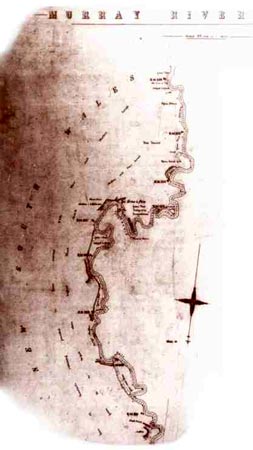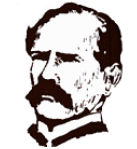
Abandoned steamboats and barges, tall red-gum wharves, small towns that show evidence of once having been much larger, old station homesteads that face the Murray. To the river traveller all these are constant reminders of the days when hundreds of steamers raced along the Murray, opening up large areas in New South Wales, Victoria and South Australia. For many settlers they were the only source of supply and contact with the outside world.
After Sturt first discovered and named the Murray in 1830, it was over twenty years before the first steamboats made their way upstream. In 1853 the "Mary Ann", skippered by William Randell, and the 'Lady Augusta", under Captain Francis Cadell, ran an unexpected race up-river, each sure of being the first to open up the Murray for traffic. When the 'Lady Augusta' passed the 'Mary Ann' just above the Murrumbidgee Junction, the race was on, resulting in the 'Lady Augusta' arriving at the tiny settlement of Swan Hill only hours before the 'Mary Ann'. Both were greeted with much enthusiasm and hospitality by the few settlers along the way. Randell took the 'Mary Ann' on up to Moama, while Cadell, after travelling a short distance upstream, turned back for Goolwa.

Francis Cadell

William Randell
By 1860 there were seventeen steamers trading and operating on the river, and by 1863 the new town of Echuca had a population of 300. Less than tens years later the population was 1600, and Echuca was Victoria's second largest port with 240 boats annually trading in all types of goods, particularly wool. Steamboats pushed up the Darling, Murrumbidgee, Murray, and the many small tributaries, opening up just on 4000 miles of waterway, and making it one of the longest navigable river systems in the world. Weirs have now reduced the navigable length considerably.
Land serviced by the Murray-Darling system was rapidly opened up, as transport of produce was assured and supplies of equipment, labour and stores became readily and cheaply available.
By the turn of the century the steamboat era was rapidly opened up, as transport of produce was assured and supplies of equipment, labour and stores became readily and cheaply available.
Eventually boats were tied up all along the Murray, waiting for work that never came. Some sank or were broken up. A few ran half-way through this century, as fishing boats, logging steamers and passenger boats. The P.S. 'Industry' was still operating as a snagging steamer at the 'bottom end' well into the 1960s. During the 1956 floods, the P.S.'Success' was put into commission to take wool from floodbound stations on the Darling, and passenger steamers still operate on the Murray, taking tourists along the peaceful reaches of our biggest river. The Murray is still navigable for 1986 kilometres.



